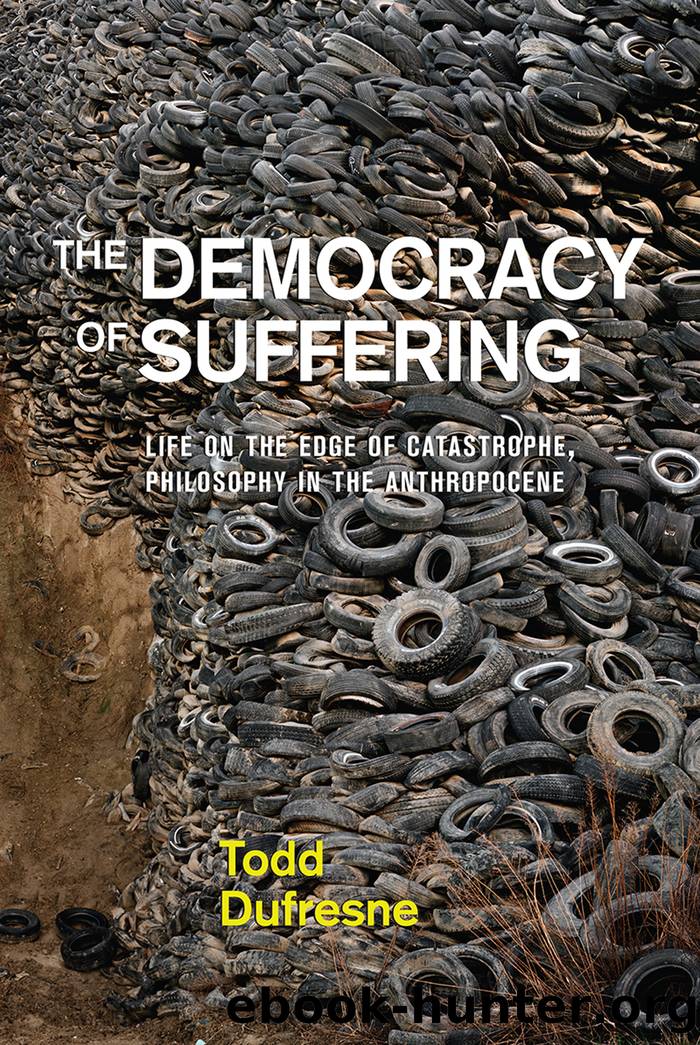The Democracy of Suffering by Dufresne Todd;

Author:Dufresne, Todd;
Language: eng
Format: epub
Publisher: McGill-Queen's University Press
Published: 2019-07-14T16:00:00+00:00
Copernicus, courtesy of Pixabay
Or as he already says in his address of 1955, the ever-changing forces of technology “claim, enchain, drag along, press and impose upon man” a stupefying “indifference toward meditative thinking” – which is, in sum, the “essential nature” of human beings (1955, 51, 56). Despite the role Heidegger played within the Nazi bureaucracy (as university rector) between 1933 and 1934, he concedes that technological rationality made monstrosities like the concentration camp possible. (These rare remarks once seemed enough to excuse his politics as merely naïve.) Like others of his generation and after, the greatest icon of technology in the mid-twentieth century was therefore the mushroom cloud – nuclear annihilation by unchecked, ungrounded, inhuman instrumental rationality. By can-do American rationality. But the slippery slope includes any technologies that alienate humanity from Being, from existence, from our Dasein, our being-in-the-world. Or again, functionality trumps what Heidegger calls Bodenständigkeit, our rootedness to earth – a sometimes ponderous feature of his worldview parodied in Hal Ashby’s great movie of 1979, Being There, starring Peter Sellers as the dunce-philosopher.
Heidegger’s critique is powerful, coherent, and in many ways convincing. But Heidegger, like the Frankfurt critics before him, doesn’t get the last word on the meaning of a world mediated by technology. For Heidegger’s phobic rejection of technology, like that of Jacques Ellul and others of the era, is undone by its naïve, utterly romantic view of authenticity and nature. As such it seems very much of-its-time. In fact, it was impossibly dated already in the 1960s. The truth is that many intellectuals in Heidegger’s own time thought quite differently about the Apollo photographs. Lazier notes, for example, that the German historian Hans Blumenberg considered Earthrise and Blue Marble to be moments, not of alienation from earth but of self-conscious reconciliation of our finite place against the backdrop of infinite space. And there is really no doubt at all. The pictures mark the emergence of a new recognition, not of individual subjects set apart from one another, but of our existentially fraught collectivity as members of one planet – what Cosgrove calls the Whole-Earth concept. The Apollo pictures punctuate, in turn, the shift to an ecological consciousness, as registered by the growth, for instance, of the Whole Earth Catalog and by environmentalism more generally. It also made possible many of the hallmarks we associate with that other emergent and totalizing concept of our own time: the Anthropocene.
In the previous century Nietzsche prophetically declared the death of God, announcing the absolute and also paralyzing freedom of an existence beyond the old categories of good and evil. Human beings are the sole measure of all things. Human beings make value and so are impelled, in Nietzsche’s terms, to revalue all values hitherto. In a way, Earthrise and Blue Marble make tangible this glimpse at absolute freedom, consolidating in two photographs the recognition that human beings are truly alone, adrift in space, one living planet among all the apparent nothingness around us. This recognition frightened people like
Download
This site does not store any files on its server. We only index and link to content provided by other sites. Please contact the content providers to delete copyright contents if any and email us, we'll remove relevant links or contents immediately.
The remains of the day by Kazuo Ishiguro(8410)
Tools of Titans by Timothy Ferriss(7828)
Giovanni's Room by James Baldwin(6820)
The Black Swan by Nassim Nicholas Taleb(6783)
Inner Engineering: A Yogi's Guide to Joy by Sadhguru(6449)
The Way of Zen by Alan W. Watts(6292)
Asking the Right Questions: A Guide to Critical Thinking by M. Neil Browne & Stuart M. Keeley(5362)
The Power of Now: A Guide to Spiritual Enlightenment by Eckhart Tolle(5347)
The Six Wives Of Henry VIII (WOMEN IN HISTORY) by Fraser Antonia(5242)
Astrophysics for People in a Hurry by Neil DeGrasse Tyson(5004)
12 Rules for Life by Jordan B. Peterson(4166)
Housekeeping by Marilynne Robinson(4070)
The Ethical Slut by Janet W. Hardy(4042)
Skin in the Game by Nassim Nicholas Taleb(3978)
Double Down (Diary of a Wimpy Kid Book 11) by Jeff Kinney(3936)
Ikigai by Héctor García & Francesc Miralles(3902)
The Art of Happiness by The Dalai Lama(3851)
Skin in the Game: Hidden Asymmetries in Daily Life by Nassim Nicholas Taleb(3736)
Walking by Henry David Thoreau(3689)
